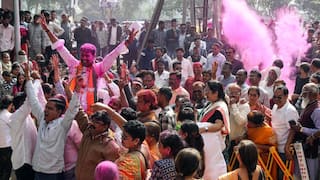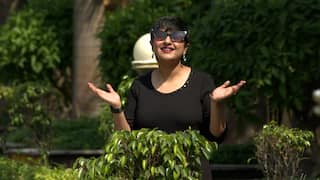Jyotish Peeth Shankaracharya Prevented From Doing 'Parikrama' Of Gyanvapi Area
The police stopped him as soon as he stepped out of the Vidya Math in Sonarpur to conduct a 'parikrama' of the area in Kashi.

New Delhi: Swami Avimukteshwaranand Saraswati, the Shankaracharya of the Jyotish Peeth in Uttarakhand, was on Monday prevented from performing a circumambulation of the disputed Gyanvapi area in Varanasi in Uttar Pradesh.
The police stopped him as soon as he stepped out of the Vidya Math in Sonarpur to conduct a 'parikrama' of the area in Kashi. He was informed that Section 144 is in force in the area and he does not have permission.
Assistant Police Commissioner Awadhesh Pandey said the seer did not have permission for the 'parikrama'.
The police officer mentioned that prohibitory orders under CrPC Section 144 are currently enforced in the area. Additionally, the dispute between the Kashi Vishwanath temple and Gyanvapi mosque is pending in court.
The seer said, "It is our tradition to circumambulate the original area of Gyanvapi.... But we are being stopped from going there. We are being told that (CrPC) Section 144 has been imposed there. We are completing the process of obtaining permission (for the 'parikrama')."
Notably, he is the same Shankaracharya who had voiced concerns against the temple's consecration ceremony and refused to go to the January 22 'pran pratishtha' ceremony in Ayodhya.
Meanwhile, an application was filed in the Supreme Court earlier today seeking directions to make necessary investigation/survey of the Wuzukhana area in the Gyanvapi mosque where the alleged “Shivling” was found.
The applicant sought a recall of an earlier order by the top court that stayed the ASI survey of the Wuzukhana area.
Earlier, the apex court stayed the Allahabad High Court's order which directed a ‘scientific survey’, including carbon dating, of a "Shivling" said to have been found at the Gyanvapi mosque complex in Varanasi during a video graphics survey last year.
This comes just days after the details of ASI's survey report came out. Sharing the details, the Hindu said the ASI has in its report suggested that a Hindu temple stood before the Gyanvapi mosque was built.
"A minute study of pillars and plasters in corridors suggests that they were originally part of a pre-existing Hindu temple for their reuse in the existing structure, Vyala figures carved on either side of the lotus medallion were mutilated and after removing the stone mass from the corners, that space was decorated with floral design," advocate Vishnu Shankar Jain, representing the Hindu side, said.






































